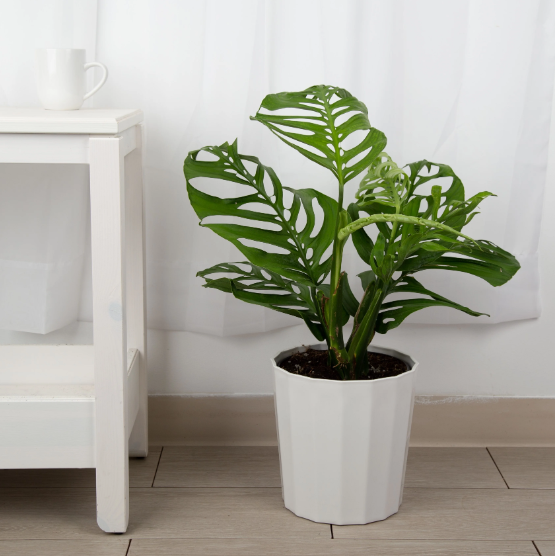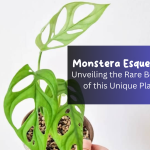Monstera plants have captivated indoor plant enthusiasts with their unique foliage, and among them, the Monstera Esqueleto stands out as a genuinely captivating variety. With its intricate leaf structure resembling a skeletal framework, this rare plant has become a favorite for collectors and enthusiasts. This comprehensive guide will delve into the fascinating world of Monstera Esqueleto, exploring its origin, care requirements, propagation methods, and the best ways to showcase its stunning beauty. Let’s embark on this green journey together!
The Origins and Characteristic
History and Discovery:
Monstera Esqueleto, scientifically known as Monstera adansonii ‘Fenestrata,’ is a variety of Monstera adansonii that displays a striking leaf pattern resembling a skeletal framework. It is characterized by its fenestrated leaves, featuring larger and elongated perforations compared to the regular Monstera adansonii. This unique appearance has made Monstera Esqueleto popular among plant enthusiasts and collectors.

Unique Leaf Structure:
What sets the Monstera Esqueleto apart is its intricate leaf structure, resembling a skeletal framework. The leaves develop fenestrations, natural holes, or perforations that form in the leaf tissue as the plant matures. These fenestrations give the Monstera adansonii ‘Fenestrata’ its distinctive appearance, adding elegance and intrigue to any space. The size and shape of the leaves may vary, with some featuring elongated and narrow shapes, while others have broader and more heart-shaped forms.
Creating the Ideal Growing Environment
Light Requirements:
Monstera Esqueleto thrives in bright, indirect light. Place it near a north or east-facing window where it can receive moderate to bright light without exposure to direct sunlight. While the plant can tolerate lower light conditions, it may result in slower growth and fewer fenestrations. If natural light is insufficient, supplement with artificial grow lights to provide the necessary brightness.
Temperature and Humidity:
Monstera Esqueleto prefers temperatures between 65-85°F (18-29°C) during the day and slightly cooler temperatures at night. It is vital to avoid exposure to cold drafts or sudden temperature fluctuations. In terms of humidity, this tropical plant appreciates higher humidity levels. You can increase humidity by using a humidifier, placing the plant on a tray filled with water and pebbles, or grouping it with other moisture-loving plants.
Watering and Fertilization:
Water your Monstera Esqueleto when the top inch of the soil feels slightly dry. Ensure that the pot has drainage holes to prevent waterlogging, which can lead to root rot. Avoid overwatering or allowing the plant to sit in standing water. During the growing season (spring and summer), fertilize the plant with a balanced, water-soluble fertilizer once a month. Dilute the fertilizer according to the manufacturer’s instructions to avoid overfeeding.
Propagation and Maintenance
Propagation Methods:
Monstera Esqueleto can be propagated through stem cuttings. Take a healthy stem cutting with at least one node and one or two leaves. Dip the cut end in a rooting hormone to promote root development and place it in a well-draining potting mix. Keep the cutting warm and humid, ensuring the soil remains moist but not soggy. Over time, roots will develop, and a new plant will emerge. Another propagation method is air layering, where a section of the stem is encouraged to root while still attached to the mother plant.
Pruning and Maintenance:
Regular pruning helps maintain the desired shape and size of your Monstera Esqueleto. Remove any yellowing or damaged leaves by snipping them off at the base. Prune selectively to encourage branching and a fuller growth habit. Inspect the plant regularly for pests such as spider mites or mealybugs. If detected, treat them promptly with insecticidal soap or neem oil, following the manufacturer’s instructions.
Displaying the Beauty of Monstera Esqueleto
Choosing the Right Container:
When selecting a container for your Monstera Esqueleto, consider functionality and aesthetics. Choose a pot with drainage holes to prevent waterlogging and ensure adequate airflow to the roots. The pot size should be appropriate for the plant’s current size, allowing room for growth. Additionally, consider the material of the pot—options such as ceramic, terracotta, or decorative planters can enhance the overall visual appeal.
Creative Placement Ideas:
The Monstera Esqueleto’s captivating appearance makes it an excellent choice for various interior styles and themes. Consider placing it in a prominent spot where it can become a focal point, such as a living room, office, or entryway. You can also create a green corner by combining the Monstera Esqueleto with other complementary plants, such as pothos or ferns. Hanging baskets or macrame plant hangers can add a unique touch, showcasing the plant’s trailing vines and intricate leaves.

Conclusion:
The Monstera adansonii ‘Fenestrata’ is a remarkable plant that captivates with its intricate skeletal leaf structure. By providing the ideal growing conditions, practicing proper maintenance techniques, and showcasing its beauty creatively, you can cultivate a stunning Monstera adansonii ‘Fenestrata’ that will envy any indoor plant enthusiast. So, why not embark on this exciting journey and welcome the elegance of the Monstera Esqueleto into your home? With patience and care, you can enjoy the enchanting presence of this extraordinary plant. Read article about Fiddle Leaf Fig Bacterial Infection and Dying Overwatered Hibiscus in Avi Hoffman Garden.
FAQ
Yes, Monstera Esqueleto is considered a rare plant variety. It is sought after by plant collectors and enthusiasts due to its unique skeletal leaf structure. While it may be more challenging to find than other Monstera varieties, it can sometimes be obtained through specialized nurseries, online plant retailers, or plant trades and exchanges.
Monstera adansonii and Monstera Esqueleto are related, but they have distinct differences. Monstera adansonii, also known as the Swiss Cheese Plant, has leaves that are generally smaller and more perforated with irregular-shaped holes. In contrast,Monstera adansonii ‘Fenestrata’ is a cultivar of Monstera adansonii and is specifically valued for its unique leaf structure resembling a skeletal framework. The fenestrations (holes) in Monstera Esqueleto leaves are larger and more elongated, creating a distinct and captivating appearance.
Monstera Esqueleto is generally considered a moderately fast-growing plant under ideal conditions. However, its growth rate may vary depending on light levels, temperature, humidity, and overall care. Providing the plant with bright, indirect light, adequate moisture, and proper nutrition can help promote healthier and more vigorous growth. While it may grow slower than other Monstera varieties, with patience and care, Monstera adansonii ‘Fenestrata’ can develop into a stunning and visually striking plant.







